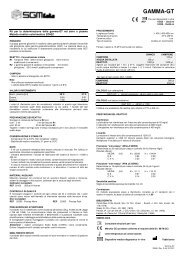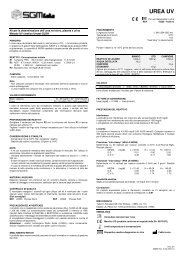TOTAL BILIRUBIN LR - Sgmitalia.com
TOTAL BILIRUBIN LR - Sgmitalia.com
TOTAL BILIRUBIN LR - Sgmitalia.com
You also want an ePaper? Increase the reach of your titles
YUMPU automatically turns print PDFs into web optimized ePapers that Google loves.
Kit per la determinazione della bilirubina totale nel siero o plasma<br />
Metodo colorimetrico Jendrassik-Grof modificato<br />
PRINCIPIO<br />
La bilirubina totale reagisce in ambiente acido con l’acido solfanilico e, in<br />
presenza di specifici acceleranti di reazione, forma un azo<strong>com</strong>posto colorato<br />
(azobilirubina) la cui intensità di colore è proporzionale alla concentrazione di<br />
bilirubina totale nel campione.<br />
REATTIVI - Concentrazione iniziale<br />
R1 Acido solfanilico 9.98 mmol/l; acido citrico 0.95 mol/l; caffeina 0.49 mol/l;<br />
urea 2.6 mol/l; conservanti e tensioattivi non anionici<br />
R2 Sodio nitrito 12.4 mmol/l<br />
CAMPIONI<br />
- Siero o plasma anticoagulato con EDTA-Na2.<br />
Note<br />
- Non utilizzare campioni emolizzati.<br />
- Poiché la bilirubina è un pigmento fotosensibile, tenere i campioni lontani da<br />
fonti di luce e di calore. Processare immediatamente i campioni.<br />
- Per campioni non limpidi e iperlipemici si consiglia di allestire un bianco<br />
campione.<br />
VALORI DI RIFERIMENTO<br />
Adulti fino a 1.2 mg/dl (17.1 µmol/l)<br />
I valori di riferimento sono da considerarsi indicativi in quanto ogni laboratorio<br />
dovrebbe ricercare quelli della popolazione su cui opera. I risultati del test<br />
dovrebbero essere interpretati unitamente alle informazioni derivanti dalle<br />
valutazioni cliniche del paziente.<br />
CONSERVAZIONE E STABILITÁ<br />
- Conservare il kit a 15-25°C. Non congelare i reattivi.<br />
- Dopo l’apertura, i flaconi R1 e R2 sono stabili fino alla data di scadenza indicata<br />
se richiusi immediatamente dopo il prelievo, protetti da contaminazione,<br />
evaporazione, luce diretta e conservati alla temperatura corretta.<br />
- Stabilità della soluzione di lavoro (R1+ R2): 21 giorni a 2-8°C.<br />
PREPARAZIONE DEI REATTIVI<br />
I reattivi sono liquidi e pronti all’uso. Per l’utilizzo <strong>com</strong>e monoreattivo<br />
(procedimento “campione starter”) aggiungere ogni 4 ml del reattivo R1 1 ml del<br />
reattivo R2. Preparare in questo modo un quantitativo pari al fabbisogno stimato<br />
tenendo presente la stabilità del reattivo di lavoro.<br />
NOTE<br />
- Il kit con la presente metodica deve essere utilizzato in manuale. Per l’utilizzo in<br />
automatico consultare le applicazioni specifiche.<br />
- Valutare attentamente i risultati se l’estinzione del reattivo di lavoro è > 0.100 a<br />
570 nm.<br />
- Evitare di esporre i reattivi alla luce diretta, contaminazione ed evaporazione.<br />
- I volumi indicati nel procedimento possono essere variati proporzionalmente.<br />
- In caso di reclamo o di richiesta del controllo di qualità del presente kit, indicare il<br />
numero di lotto riportato sulla confezione o, in alternativa, il numero di lotto dei<br />
singoli <strong>com</strong>ponenti.<br />
MATERIALI AUSILIARI<br />
Materiali necessari non contenuti nel kit: soluzioni diluenti, vetreria e monouso,<br />
sistemi di dosaggio e misurazione, calibratori per la taratura degli strumenti.<br />
CONTROLLO DI QUALITÁ<br />
É necessario eseguire i controlli ad ogni utilizzo del kit e verificare che i valori<br />
ottenuti siano inclusi nell’intervallo di riferimento riportato nelle istruzioni d’uso.<br />
Sieri consigliati:<br />
REF 20350 Precise Norm REF 20360 Precise Path<br />
PRECAUZIONI ED AVVERTENZE<br />
Xn<br />
R22 - Nocivo per ingestione<br />
.<br />
SMALTIMENTO RIFIUTI<br />
Il prodotto deve essere smaltito secondo le locali normative in materia di gestione<br />
dei rifiuti.<br />
<strong>TOTAL</strong> <strong>BILIRUBIN</strong> <strong>LR</strong><br />
reattivo liquido<br />
Per uso diagnostico in vitro<br />
REF 10107 - 4x100 ml<br />
10108 – 2x50+2x50 ml<br />
V10108 – 8x20+2x20 ml<br />
PROCEDIMENTO<br />
Lunghezza d’onda λ: 570 (550-580) nm<br />
Temperatura di lavoro 37°C<br />
Cammino ottico 1 cm<br />
Tipo di reazione “end point” (a punto finale)<br />
- PROCEDIMENTO MONOREATTIVO “campione starter”<br />
BIANCO CAMPIONE<br />
REATTIVO DI LAVORO 1500 µl 1500 µl<br />
ACQUA DISTILLATA 100 µl --<br />
CAMPIONE -- 100 µl<br />
Agitare e poi incubare 5 min. a 37°C. Leggere l’estinzione del campione (EC) e<br />
del bianco (EBC) contro acqua.<br />
- PROCEDIMENTO BIREATTIVO “substrato starter”<br />
BIANCO CAMPIONE<br />
REATTIVO R1 1000 µl 1000 µl<br />
ACQUA DISTILLATA 80 µl --<br />
CAMPIONE -- 80 µl<br />
Mescolare, incubare per 5 min., poi aggiungere:<br />
REATTIVO R2 250 µl 250 µl<br />
Agitare e poi incubare 5 min. a 37°C. Leggere l’estinzione del campione (EC) e<br />
del bianco (EBC) contro acqua.<br />
CALCOLO<br />
Bilirubina totale [mg/dl] = (EC - EBC) x 14.5<br />
[µmol/l] = (EC - EBC) x 248<br />
FATTORE DI CONVERSIONE<br />
Bilirubina [mg/dl] x 17.0 = Bilirubina [µmol/l]<br />
PRESTAZIONI DEL REATTIVO<br />
Interferenze<br />
I trigliceridi non interferiscono sino alla concentrazione di 500 mg/dl.<br />
L’emoglobina non interferisce sino alla concentrazione di 1000 mg/dl.<br />
Linearità<br />
La reazione è lineare tra 0.05-25 mg/dl (0.85-425 µmol/l). Campioni superiori a<br />
25 mg/dl devono essere diluiti con soluzione fisiologica. Moltiplicare il risultato per<br />
il fattore di diluizione.<br />
Precisione “intra-Assay” (NELLA SERIE)<br />
Determinata su 30 replicati per ciascun controllo (L-N-H) (Low-Normal-High).<br />
Risultati ottenuti:<br />
MEDIA [mg/dl] L = 0.43 N = 1.66 H = 3.55<br />
D.S. 0.02 0.12 0.32<br />
C.V.% 5.12 7.25 9.09<br />
Precisione “inter-Assay” (FRA LE SERIE)<br />
Determinata su 15 replicati per ciascun controllo (L-N-H) per 3 giorni. Risultati<br />
ottenuti:<br />
MEDIA [mg/dl] L = 0.84 N = 1.67 H = 4.09<br />
D.S. 0.03 0.07 0.16<br />
C.V.% 4.08 4.26 4.00<br />
Sensibilità analitica<br />
Soglia di sensibilità espressa dal metodo: 0.05 mg/dl (0.85 µmol/l).<br />
Correlazione<br />
Un metodo equivalente preso a riferimento, correlato su 21 campioni con il<br />
reattivo in esame, ha dato un fattore di correlazione r = 1.00<br />
BIBLIOGRAFIA<br />
Jendrassik, L., Gróf, P., Biochem. Z., 297, 81 (1938).<br />
Jakobs, D.S., Kasten, Jr. B.L., Demmott, W.R., Wolfson, W.L.: “Laboratory Test<br />
Handbook”, Lexi-Comp and Williams & Wilkins Ed. 2nd Edition (1990).<br />
Kaplan, L.A., Pesce, A.J.: “Clinical Chemistry”, Mosby Ed. (1996).<br />
SIMBOLOGIA<br />
Consultare istruzioni per l’uso<br />
Marchio CE (prodotto conforme ai requisiti della Dir. 98/79/CE)<br />
Limiti temperatura di conservazione<br />
Dispositivo medico-diagnostico in vitro Fabbricante<br />
Total Bilirubin <strong>LR</strong><br />
30321 Rev. 2 del 2012/01
Kit for measurement of total bilirubin in serum or plasma<br />
Colorimetric method Jendrassik-Grof modified<br />
PRINCIPLE<br />
Total bilirubin reacts in acid environment with sulphanilic acid and, in presence of<br />
specific reaction catalyzers, gives a coloured azo<strong>com</strong>pound (azobilirubin) whose<br />
colour intensity is proportional to the total bilirubin concentration in the sample.<br />
REAGENTS<br />
R1 Sulphanilic acid 9.98 mmol/l; citric acid 0.95 mol/l; caffeine 0.49 mol/l;<br />
urea 2.6 mol/l; preservatives and surface-active agents not anionic<br />
R2 Nitrite sodium 12.4 mmol/l<br />
SAMPLE<br />
- Serum or EDTA-Na2 plasma.<br />
Note<br />
- Do not use samples with haemolysis.<br />
- Keep the samples far from light and heat because the bilirubin is a<br />
photosensitive pigment. Perform the samples as soon as possible.<br />
- It’s advisable to perform a blank sample for those samples which are<br />
hyperlipoemic and not clear.<br />
REFERENCE VALUES<br />
Adults up to 1.2 mg/dl (17.1 µmol/l)<br />
References values are considered indicatives since each laboratory should<br />
establish references ranges for its own patient’s population. The analytical results<br />
should be evaluated with other information <strong>com</strong>ing from patient’s clinical story.<br />
STORAGE AND STABILITY<br />
- Store the kit at 15-25°C. Do not freeze the reagents.<br />
- After opening, the vials R1 and R2 are stable up to the expiry date if recapped<br />
immediately and protected from contamination, evaporation, direct light, and<br />
stored at the correct temperature.<br />
- Working solution stability (R1+ R2): 21 days at 2-8°C.<br />
PREPARATION OF REAGENTS<br />
Reagents are liquid and ready to use. About using as monoreagent (“samplestarter”<br />
procedure) add to every 4 ml of R1 reagent, 1 ml of R2 reagent. Prepare<br />
the amount for use according to the stability of working solution.<br />
NOTE<br />
- The kit, according to this method, must be used in manual procedures. About<br />
automatic using follow specific applications.<br />
- Evaluate carefully the results if working reagent absorbance is > 0.100 at<br />
570 nm.<br />
- Avoid direct light, contamination and evaporation.<br />
- The volumes in the procedure can be changed proportionally.<br />
- In case of <strong>com</strong>plaint or quality control request, refer to the lot number on the<br />
package or the lot number on the singles vials.<br />
AUXILIARY EQUIPMENT<br />
Materials not included in the kit: diluent solutions, laboratory glassware,<br />
disposable tips, photometers and calibrators.<br />
QUALITY CONTROLS<br />
It’s necessary, every time the kit is used, to make the quality controls and to check<br />
that values obtained are within the acceptance range provided in the insert.<br />
Suggested serum:<br />
REF 20350 Precise Norm REF 20360 Precise Path<br />
PRECAUTION IN USE<br />
Xn<br />
R22 - Harmful if swallowed<br />
WASTE MANAGEMENT<br />
Please refer to the local legal requirements.<br />
<strong>TOTAL</strong> <strong>BILIRUBIN</strong> <strong>LR</strong><br />
liquid reagent<br />
For in vitro medical device<br />
REF 10107 - 4x100 ml<br />
10108 – 2x50+2x50 ml<br />
V10108 – 8x20+2x20 ml<br />
PROCEDURE<br />
Wavelength λ: 570 (550-580) nm<br />
Working temperature 37°C<br />
Optical path 1 cm<br />
Reaction “end point”<br />
- MONOREAGENT PROCEDURE “sample starter”<br />
BLANK SAMPLE<br />
WORKING REAGENT 1500 µl 1500 µl<br />
DISTILLED WATER 100 µl --<br />
SAMPLE -- 100 µl<br />
Mix, then incubate for 5’ at 37°C. Measure the final absorbance of sample (EC)<br />
and blank (EBC) against water.<br />
- BIREAGENT PROCEDURE “substrate starter”<br />
BLANK SAMPLE<br />
REAGENT R1 1000 µl 1000 µl<br />
DISTILLED WATER 80 µl --<br />
SAMPLE -- 80 µl<br />
Mix, incubate for 5’ and then add:<br />
REAGENT R2 250 µl 250 µl<br />
Mix, then incubate for 5’ at 37°C. Measure the final absorbance of sample (EC)<br />
and blank (EBC) against water.<br />
CALCULATION<br />
Total bilirubin [mg/dl] = (EC - EBC) x 14.5<br />
[µmol/l] = (EC - EBC) x 248<br />
CONVERSION FACTOR<br />
Bilirubin [mg/dl] x 17.0 = Bilirubin [µmol/l]<br />
ANALYTICAL PERFORMANCES<br />
Interferences<br />
Triglycerides do not interfere up to concentration of 500 mg/dl.<br />
Hemoglobin does not interfere up to concentration of 1000 mg/dl.<br />
Linearity<br />
Reaction is linear between 0.05-25 mg/dl (0.85-425 µmo/l). Samples with values<br />
exceeding 25 mg/dl must be diluted with saline solution. Multiply, then, the result<br />
for diluting factor.<br />
“Intra Assay” precision (within-Run)<br />
Determined on 30 samples for each control (L-N-H) (Low-Normal-High).<br />
Results:<br />
MEAN [mg/dl] L = 0.43 N = 1.66 H = 3.55<br />
S.D. 0.02 0.12 0.32<br />
C.V.% 5.12 7.25 9.09<br />
“Inter Assay” precision (between-Run)<br />
Determined on 15 samples for each control (L-N-H) for 3 days.<br />
Results:<br />
MEAN [mg/dl] L = 0.84 N = 1.67 H = 4.09<br />
S.D. 0.03 0.07 0.16<br />
C.V.% 4.08 4.26 4.00<br />
Analytical sensitivity<br />
The test sensitivity in terms of detection limit is 0.05 mg/dl (0.85 µmo/l).<br />
Correlation<br />
A study based <strong>com</strong>paring this method with a similar method on 21 samples has<br />
given a correlating factor r = 1.00<br />
BIBLIOGRAPHY<br />
Jendrassik, L., Gróf, P., Biochem. Z., 297, 81 (1938).<br />
Jakobs, D.S., Kasten, Jr. B.L., Demmott, W.R., Wolfson, W.L.: “Laboratory Test<br />
Handbook”, Lexi-Comp and Williams & Wilkins Ed. 2nd Edition (1990).<br />
Kaplan, L.A., Pesce, A.J.: “Clinical Chemistry”, Mosby Ed. (1996).<br />
SYMBOLS<br />
Read instruction for use<br />
CE mark (requirement of 98/79 regulation)<br />
Storaging temperature limits<br />
In vitro medical device Producer<br />
Total Bilirubin <strong>LR</strong><br />
30321 Rev. 2 of 2012/01
















